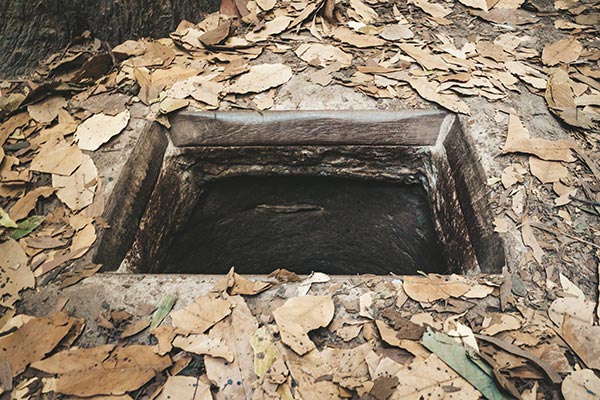 Parler
Parler Gab
Gab
- The practice of caching, or hiding supplies, has deep historical roots in asymmetrical warfare and is now a cornerstone of modern preparedness.
- Secrecy is paramount; the knowledge of a stockpile is a vulnerability that can spread quickly through casual conversation.
- Diversifying hiding spots, both inside and outside the home, prevents the total loss of supplies if one location is discovered.
- Psychological tactics, such as leaving a "sacrificial stash," can mislead looters into believing they have found everything of value.
- Creative concealment methods, from modified furniture to false walls and buried outdoor containers, leverage everyday objects to create secure hiding places.
The guerrilla history of hiding your goods
The impulse to bury valuables is not new. It is a thread that runs through the history of every resistance movement that has faced a superior force. As detailed in the guide by authors Joe Nobody and T. Pike, the French Resistance during the Nazi occupation relied on cached weapons and supplies air-dropped by the Allies, hiding them in bread panniers, culverts, and holes in the ground. Decades later, the Viet Cong elevated this tactic to an art form, constructing elaborate underground tunnel systems to hide not just weapons, but the very means to sustain their prolonged campaign. They would attack, break contact, bury their gear, and vanish into the local population, a tactic that caused immense frustration for American troops. One of the authors, a former Marine in Afghanistan, witnessed this firsthand, recalling the discovery of a crude cache after a firefight, a PKM machine gun hidden beneath a burning pile of hay. He notes that for every cache found, countless others likely remained hidden, a testament to the method's effectiveness. This martial history provides a stark backdrop for the modern prepper, who may not be facing a mighty army but understands the principle: what is hidden cannot be easily taken.Thinking like a looter to outsmart them
The first and most critical step in protecting a stockpile begins long before any disaster, in the quiet routine of daily life. The cardinal rule is secrecy. Bragging to a friend, posting on an online forum, or even letting a child mention the family’s preparations to a schoolmate can unwittingly broadcast your readiness to a wide audience. When society frays, that knowledge becomes a map for desperate people. The next step requires a shift in mindset, to see your own home through the eyes of a looter. They are not forensic experts; they are rushed, desperate, and will head for the obvious spots first—the pantry, the garage, the master bedroom closet. This is precisely why storing firearms in these common locations is a significant risk. A burglar, whether in peaceful times or during a collapse, knows to ransack the nightstand and the closet. Hiding them in uncommon, creatively concealed spots is the only way to ensure they remain in the owner’s hands. This psychological game can be advanced further with the concept of a "sacrificial stash." By leaving a small, meager collection of supplies in an obvious location—a few open boxes of food, water jugs with only a few sips left—a prepper can create a powerful illusion. Looters who find this will likely assume the homeowners have already been picked clean or were poorly prepared. They take the paltry offering and move on, never suspecting that the true wealth of supplies is hidden in plain sight, tucked away in a network of smaller, more creative caches. This strategy of diversification is crucial; putting all your survival eggs in one basket is a gamble with catastrophic odds.From false floors to buried barrels: A guide to concealment
The practical application of this philosophy turns a home into a puzzle box of hidden compartments. Inside, the opportunities are limited only by creativity. Hollowed-out furniture, like an ottoman or a bed frame, can create significant hidden voids. A false wall behind a narrow, paneled-over bookcase can conceal long-term non-perishables, accessed only when truly needed. For those with a hand for minor carpentry, false floors are a classic and effective method. One can nail old milk crates to the stringers beneath a closet floor, covering them with thin flooring and a carpet. No one stepping into a small closet would notice the slight give, and the cache remains accessible by peeling back the corner of the carpet. For basements, a hidden root cellar fashioned from painted cinderblocks can wall off a section of the foundation, invisible to anyone who isn't taking measurements. Even an old, decommissioned fuel oil tank can be cut open along its seam, filled with goods, resealed, and repainted to become a massive, unsuspected vault. The final layer of security, however, lies beyond the home's walls. Burying supplies on one's property is the ultimate insurance policy. As the military guide emphasizes, searching a house is far easier than digging up an entire pasture. A properly sealed 55-gallon drum or a five-gallon bucket, buried with its lid just inches below the surface, creates a weatherproof, temperature-regulated stash. A raised garden bed can serve as a distraction for a buried cache of weapons and supplies. If a home is overrun, these buried caches become lifelines, allowing a family to flee and later return under cover of darkness to retrieve enough supplies to survive. Even a rain barrel can be weaponized for concealment; an extra, non-functional barrel can store sealed bags of supplies, or an existing one can have goods submerged inside, giving the appearance of a normal water source to any casual observer. In the end, these methods are not about paranoia, but about a quiet, confident self-sufficiency. It is the understanding that in an uncertain world, the most valuable things are those that no one else knows exist. Sources include: AskaPrepper.com Survival.news Enoch, Brighteon.aiHydroponics and aeroponics: Revolutionizing resilient food production for preppers
By Evangelyn Rodriguez // Share
“Bio-Veda” on BrightU: Building your future from concept to community
By Jacob Thomas // Share
Nearly half of Japanese public supports military intervention to defend Taiwan, poll finds
By Belle Carter // Share
Stop wasting money: Slash your Organic Dairy bill without sacrificing taste
By HRS Editors // Share
How to protect your electronics from EMP: Faraday cages and survival strategies
By Evangelyn Rodriguez // Share
Six Amish survival foods that outlast crises and empower self-reliance
By Lance D Johnson // Share
Governments continue to obscure COVID-19 vaccine data amid rising concerns over excess deaths
By patricklewis // Share
Tech giant Microsoft backs EXTINCTION with its support of carbon capture programs
By ramontomeydw // Share
Germany to resume arms exports to Israel despite repeated ceasefire violations
By isabelle // Share










